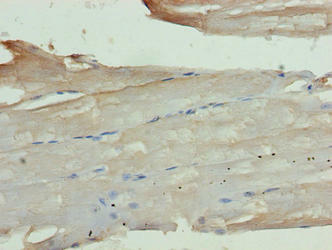Description
| Antibody Name: | KCNK13 Antibody (PACO40450) |
| Antibody SKU: | PACO40450 |
| Size: | 50ug |
| Host Species: | Rabbit |
| Tested Applications: | ELISA, WB, IHC, IF |
| Recommended Dilutions: | ELISA:1:2000-1:10000, WB:1:500-1:2000, IHC:1:20-1:200, IF:1:50-1:200 |
| Species Reactivity: | Human |
| Immunogen: | Recombinant Human Potassium channel subfamily K member 13 protein (292-408AA) |
| Form: | Liquid |
| Storage Buffer: | Preservative: 0.03% Proclin 300 Constituents: 50% Glycerol, 0.01M PBS, PH 7.4 |
| Purification Method: | >95%, Protein G purified |
| Clonality: | Polyclonal |
| Isotype: | IgG |
| Conjugate: | Non-conjugated |
 | Western blot. All lanes: KCNK13 antibody at 8µg/ml. Lane 1: HepG2 whole cell lysate. Lane 2: LO2 whole cell lysate. Secondary. Goat polyclonal to rabbit IgG at 1/10000 dilution. Predicted band size: 46 kDa. Observed band size: 46 kDa. |
 | Immunohistochemistry of paraffin-embedded human glioma using PACO40450 at dilution of 1:100. |
 | Immunohistochemistry of paraffin-embedded human skeletal muscle tissue using PACO40450 at dilution of 1:100. |
| Background: | Potassium channel displaying weak inward rectification in symmetrical K(+) solution. |
| Synonyms: | Potassium channel subfamily K member 13 (Tandem pore domain halothane-inhibited potassium channel 1) (THIK-1), KCNK13 |
| UniProt Protein Function: | KCNK13: Potassium channel displaying weak inward rectification in symmetrical K(+) solution. Belongs to the two pore domain potassium channel (TC 1.A.1.8) family.Protein type: Membrane protein, multi-pass; Membrane protein, integralChromosomal Location of Human Ortholog: 14q32.11Cellular Component: integral to membrane; plasma membraneMolecular Function: potassium channel activity; voltage-gated ion channel activityBiological Process: synaptic transmission |
| UniProt Protein Details: | |
| NCBI Summary: | Potassium channels represent the most complex class of voltage-gated ion channels from both functional and structural standpoints. Their diverse functions include regulating neurotransmitter release, heart rate, insulin secretion, neuronal excitability, epithelial electrolyte transport, smooth muscle contraction, and cell volume. This gene encodes a potassium channel containing two pore-forming domains. This protein is an open channel that can be stimulated by arachidonic acid and inhibited by the anesthetic halothane. [provided by RefSeq, Jul 2013] |
| UniProt Code: | Q9HB14 |
| NCBI GenInfo Identifier: | 16306555 |
| NCBI Gene ID: | 56659 |
| NCBI Accession: | NP_071337.2 |
| UniProt Secondary Accession: | Q9HB14,Q96E79 |
| UniProt Related Accession: | Q9HB14 |
| Molecular Weight: | 45,391 Da |
| NCBI Full Name: | potassium channel subfamily K member 13 |
| NCBI Synonym Full Names: | potassium channel, subfamily K, member 13 |
| NCBI Official Symbol: | KCNK13 |
| NCBI Official Synonym Symbols: | THIK1; THIK-1; K2p13.1 |
| NCBI Protein Information: | potassium channel subfamily K member 13; K2P13.1 potassium channel; tandem pore domain potassium channel THIK-1; tandem pore domain halothane-inhibited potassium channel 1 |
| UniProt Protein Name: | Potassium channel subfamily K member 13 |
| UniProt Synonym Protein Names: | Tandem pore domain halothane-inhibited potassium channel 1 |
| Protein Family: | Potassium channel subfamily |
| UniProt Gene Name: | KCNK13 |
| UniProt Entry Name: | KCNKD_HUMAN |






